Female Foeticide in India
VerifiedAdded on 2023/04/21
|10
|3780
|268
AI Summary
This article discusses the issue of female foeticide in India, focusing on its causes, consequences, and possible solutions. It explores the violation of women's rights and the impact on the sex ratio. The article also highlights the role of social work in addressing this issue and promoting equality among women and men.
Contribute Materials
Your contribution can guide someone’s learning journey. Share your
documents today.

RUNNING HEAD: Social work human right 0
Social work human right
Social work human right
Secure Best Marks with AI Grader
Need help grading? Try our AI Grader for instant feedback on your assignments.

Social work human right 1
Female foeticide in India
Females are assassinated all over the domain. But in India, the killing of females takes
place on the regular basis, even before they are born. It is truly cursed on the Indian society.
The practice of ending a fetus, though it is still in the womb just for it is female is recognized
as female feticide. It is done afterwards predicting the gender of the child formerly it is born
through ultrasound scans. The female foeticide has turn out to be disgraceful in the nations
like India (Ramaswamy, 2017). Although, it is illegal in India The killing of more than one
million females in India on the annual basis causes disastrous significances. In certain
regions, the sex ratio of females to males has fallen to less than 8000:1000. The females get
to face not only disparity in the culture but are even left without the right to be born
(Bhattacharya & Singh, 2017). It is illegal to determine the fetus sex in India. But here are
some agencies which conduct this practice illegally. The female feticide is run by various
aspects like the viewpoint of having to pay a dowry to the prospect husband of a daughter. It
makes daughters an unaffordable economic burden on society. The preference of son over the
daughter is the prime reason behind the female infanticide. The sons provide protection to the
families in the old age whereas the daughters are considered as the economic and social
burden. Sons are also allowed to execute the cremations for the souls of defunct parents and
descendants. On the other side, ritually women are not allowed to perform such rites. The
practice of female foeticide is done itself by the mothers due to the family pressures (Rubin &
Babbie, 2016).
The prenatal sex detection technologies are misused by the people in India as it allows
discerning abortions of the females. The female infanticide is committed for a long time in
India but feticide is a disciplinary offense. The feticide is comparatively an innovative
practice and emerging with the arrival of scientific developments in the prenatal sex fortitude
in the 1990s. The abortion is permissible in India but aborting a pregnancy is not allowed if
the fetus is female. Here are severe laws and consequences for the violators in India.
Although, these laws have not been successful to control such repulsive practices (Gautam,
Jhariya & Kumar, 2015). The gender biases are the reason behind the attitude of the
patriarchal Indian society. The Vedas even highlighted the requirement of the son. The
medical procedure conducted to determine the sexes of the unborn child is Amniocentesis,
ultrasonography, foetoscopy, chronic villi biopsy and placement tissue sampling. Out of this
option, most commonly used is amniocentesis. This technology was meant to use as
Female foeticide in India
Females are assassinated all over the domain. But in India, the killing of females takes
place on the regular basis, even before they are born. It is truly cursed on the Indian society.
The practice of ending a fetus, though it is still in the womb just for it is female is recognized
as female feticide. It is done afterwards predicting the gender of the child formerly it is born
through ultrasound scans. The female foeticide has turn out to be disgraceful in the nations
like India (Ramaswamy, 2017). Although, it is illegal in India The killing of more than one
million females in India on the annual basis causes disastrous significances. In certain
regions, the sex ratio of females to males has fallen to less than 8000:1000. The females get
to face not only disparity in the culture but are even left without the right to be born
(Bhattacharya & Singh, 2017). It is illegal to determine the fetus sex in India. But here are
some agencies which conduct this practice illegally. The female feticide is run by various
aspects like the viewpoint of having to pay a dowry to the prospect husband of a daughter. It
makes daughters an unaffordable economic burden on society. The preference of son over the
daughter is the prime reason behind the female infanticide. The sons provide protection to the
families in the old age whereas the daughters are considered as the economic and social
burden. Sons are also allowed to execute the cremations for the souls of defunct parents and
descendants. On the other side, ritually women are not allowed to perform such rites. The
practice of female foeticide is done itself by the mothers due to the family pressures (Rubin &
Babbie, 2016).
The prenatal sex detection technologies are misused by the people in India as it allows
discerning abortions of the females. The female infanticide is committed for a long time in
India but feticide is a disciplinary offense. The feticide is comparatively an innovative
practice and emerging with the arrival of scientific developments in the prenatal sex fortitude
in the 1990s. The abortion is permissible in India but aborting a pregnancy is not allowed if
the fetus is female. Here are severe laws and consequences for the violators in India.
Although, these laws have not been successful to control such repulsive practices (Gautam,
Jhariya & Kumar, 2015). The gender biases are the reason behind the attitude of the
patriarchal Indian society. The Vedas even highlighted the requirement of the son. The
medical procedure conducted to determine the sexes of the unborn child is Amniocentesis,
ultrasonography, foetoscopy, chronic villi biopsy and placement tissue sampling. Out of this
option, most commonly used is amniocentesis. This technology was meant to use as
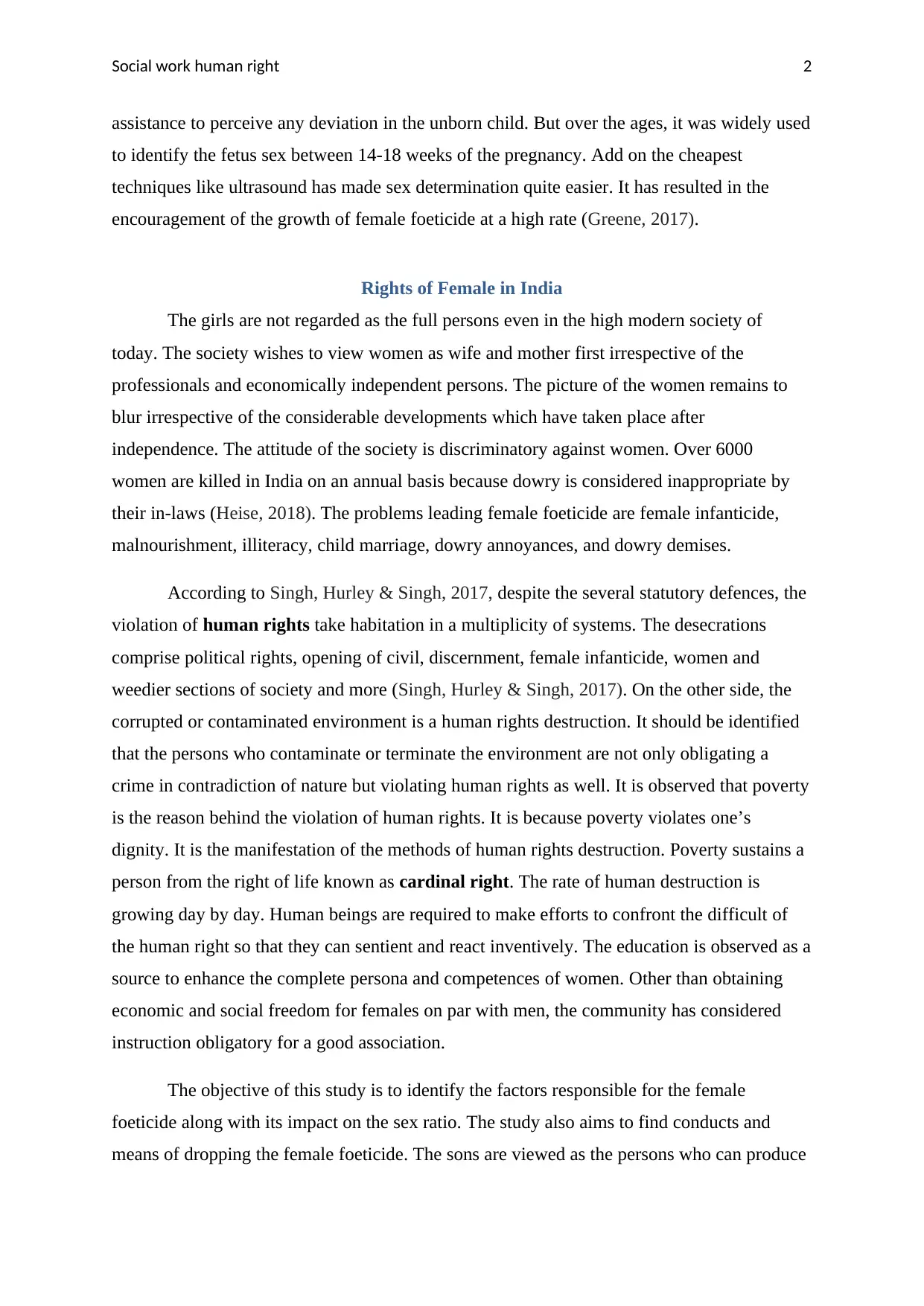
Social work human right 2
assistance to perceive any deviation in the unborn child. But over the ages, it was widely used
to identify the fetus sex between 14-18 weeks of the pregnancy. Add on the cheapest
techniques like ultrasound has made sex determination quite easier. It has resulted in the
encouragement of the growth of female foeticide at a high rate (Greene, 2017).
Rights of Female in India
The girls are not regarded as the full persons even in the high modern society of
today. The society wishes to view women as wife and mother first irrespective of the
professionals and economically independent persons. The picture of the women remains to
blur irrespective of the considerable developments which have taken place after
independence. The attitude of the society is discriminatory against women. Over 6000
women are killed in India on an annual basis because dowry is considered inappropriate by
their in-laws (Heise, 2018). The problems leading female foeticide are female infanticide,
malnourishment, illiteracy, child marriage, dowry annoyances, and dowry demises.
According to Singh, Hurley & Singh, 2017, despite the several statutory defences, the
violation of human rights take habitation in a multiplicity of systems. The desecrations
comprise political rights, opening of civil, discernment, female infanticide, women and
weedier sections of society and more (Singh, Hurley & Singh, 2017). On the other side, the
corrupted or contaminated environment is a human rights destruction. It should be identified
that the persons who contaminate or terminate the environment are not only obligating a
crime in contradiction of nature but violating human rights as well. It is observed that poverty
is the reason behind the violation of human rights. It is because poverty violates one’s
dignity. It is the manifestation of the methods of human rights destruction. Poverty sustains a
person from the right of life known as cardinal right. The rate of human destruction is
growing day by day. Human beings are required to make efforts to confront the difficult of
the human right so that they can sentient and react inventively. The education is observed as a
source to enhance the complete persona and competences of women. Other than obtaining
economic and social freedom for females on par with men, the community has considered
instruction obligatory for a good association.
The objective of this study is to identify the factors responsible for the female
foeticide along with its impact on the sex ratio. The study also aims to find conducts and
means of dropping the female foeticide. The sons are viewed as the persons who can produce
assistance to perceive any deviation in the unborn child. But over the ages, it was widely used
to identify the fetus sex between 14-18 weeks of the pregnancy. Add on the cheapest
techniques like ultrasound has made sex determination quite easier. It has resulted in the
encouragement of the growth of female foeticide at a high rate (Greene, 2017).
Rights of Female in India
The girls are not regarded as the full persons even in the high modern society of
today. The society wishes to view women as wife and mother first irrespective of the
professionals and economically independent persons. The picture of the women remains to
blur irrespective of the considerable developments which have taken place after
independence. The attitude of the society is discriminatory against women. Over 6000
women are killed in India on an annual basis because dowry is considered inappropriate by
their in-laws (Heise, 2018). The problems leading female foeticide are female infanticide,
malnourishment, illiteracy, child marriage, dowry annoyances, and dowry demises.
According to Singh, Hurley & Singh, 2017, despite the several statutory defences, the
violation of human rights take habitation in a multiplicity of systems. The desecrations
comprise political rights, opening of civil, discernment, female infanticide, women and
weedier sections of society and more (Singh, Hurley & Singh, 2017). On the other side, the
corrupted or contaminated environment is a human rights destruction. It should be identified
that the persons who contaminate or terminate the environment are not only obligating a
crime in contradiction of nature but violating human rights as well. It is observed that poverty
is the reason behind the violation of human rights. It is because poverty violates one’s
dignity. It is the manifestation of the methods of human rights destruction. Poverty sustains a
person from the right of life known as cardinal right. The rate of human destruction is
growing day by day. Human beings are required to make efforts to confront the difficult of
the human right so that they can sentient and react inventively. The education is observed as a
source to enhance the complete persona and competences of women. Other than obtaining
economic and social freedom for females on par with men, the community has considered
instruction obligatory for a good association.
The objective of this study is to identify the factors responsible for the female
foeticide along with its impact on the sex ratio. The study also aims to find conducts and
means of dropping the female foeticide. The sons are viewed as the persons who can produce

Social work human right 3
money and care for the parents in the upcoming years. On the other side, do not cooperate
with the family as they get married and go to another family. The son pursuits the name of
the family and the daughter becomes the part of the in-law’s family. The people also carry the
assumption that sons are considered as a eminence sign to have a son and shame to have a
daughter. The woman suffers from the pressure of having a boy that they themselves take the
decision to get sex determination test. So, that they can abort if it is a baby girl. The tags like
illiteracy and poverty are consigned to the girl child. It makes a strong desire to have a baby
boy. The women are forced to endure numerous pregnancies and abortions in order to fulfill
the ambition of having a son in order to fulfill the desire of the family (Neogi, et. al. 2015).
The modern technology has enabled to decide the gender of the child while it is in the womb.
It gives options to the would-be parents to abort the fetus and endure to strain to conceive till
they get the baby boy. The sex determination is completely banned in India but people
anyhow find ways to identify the child sex. There are plenty of scanning centers in India
which enable the information. Add on there are plenty of wealthy families in India, who
obtain the information of sex by flying to the neighboring nations where sex fortitude is legal.
There was the prevalence of the ultrasound machineries in India in the 1990s to identify the
gender (Sen, 2018). Most of the feminine foeticide cases intricate animated participation of
both old and young women. In order to augment fuel to the fire, illegal sex identification and
discerning abortion infants convert a booming US $224 million industry. It was a hazardous
enticement for the prosperity of the society now the coming years.
According to Mehta, et. al. 2017, The Indian society acknowledges an intense trust in
every person’s right to life and pride. The rights concerning girl child were violated in
Indian society. The major reason behind the female foeticides is the dominant position of
men in important decisions (Mehta, et. al. 2017). The women are discriminated in the
families and society. The Indian society sustains double standard in the circumstances like
education, marriage, domestic fierceness, property laws, masculine society laws, dowry
scheme, sexual nuisance, acknowledgment and admiration for the women. The partiality of
the male child is also the reason behind the female feticide. The elimination of the girl child
even before birth specifies the aspiration for the baby boy. The sons are considered as the
major basis of income and go to take a generation to another level. However, women lead in
every field and leave behind to men. The misconception remains in the society that male will
run out of the house and look after the parents. According to Yadav, et. al. 2018, the status of
a woman is resolute in society by their health, education, their role in the economy,
money and care for the parents in the upcoming years. On the other side, do not cooperate
with the family as they get married and go to another family. The son pursuits the name of
the family and the daughter becomes the part of the in-law’s family. The people also carry the
assumption that sons are considered as a eminence sign to have a son and shame to have a
daughter. The woman suffers from the pressure of having a boy that they themselves take the
decision to get sex determination test. So, that they can abort if it is a baby girl. The tags like
illiteracy and poverty are consigned to the girl child. It makes a strong desire to have a baby
boy. The women are forced to endure numerous pregnancies and abortions in order to fulfill
the ambition of having a son in order to fulfill the desire of the family (Neogi, et. al. 2015).
The modern technology has enabled to decide the gender of the child while it is in the womb.
It gives options to the would-be parents to abort the fetus and endure to strain to conceive till
they get the baby boy. The sex determination is completely banned in India but people
anyhow find ways to identify the child sex. There are plenty of scanning centers in India
which enable the information. Add on there are plenty of wealthy families in India, who
obtain the information of sex by flying to the neighboring nations where sex fortitude is legal.
There was the prevalence of the ultrasound machineries in India in the 1990s to identify the
gender (Sen, 2018). Most of the feminine foeticide cases intricate animated participation of
both old and young women. In order to augment fuel to the fire, illegal sex identification and
discerning abortion infants convert a booming US $224 million industry. It was a hazardous
enticement for the prosperity of the society now the coming years.
According to Mehta, et. al. 2017, The Indian society acknowledges an intense trust in
every person’s right to life and pride. The rights concerning girl child were violated in
Indian society. The major reason behind the female foeticides is the dominant position of
men in important decisions (Mehta, et. al. 2017). The women are discriminated in the
families and society. The Indian society sustains double standard in the circumstances like
education, marriage, domestic fierceness, property laws, masculine society laws, dowry
scheme, sexual nuisance, acknowledgment and admiration for the women. The partiality of
the male child is also the reason behind the female feticide. The elimination of the girl child
even before birth specifies the aspiration for the baby boy. The sons are considered as the
major basis of income and go to take a generation to another level. However, women lead in
every field and leave behind to men. The misconception remains in the society that male will
run out of the house and look after the parents. According to Yadav, et. al. 2018, the status of
a woman is resolute in society by their health, education, their role in the economy,
Secure Best Marks with AI Grader
Need help grading? Try our AI Grader for instant feedback on your assignments.
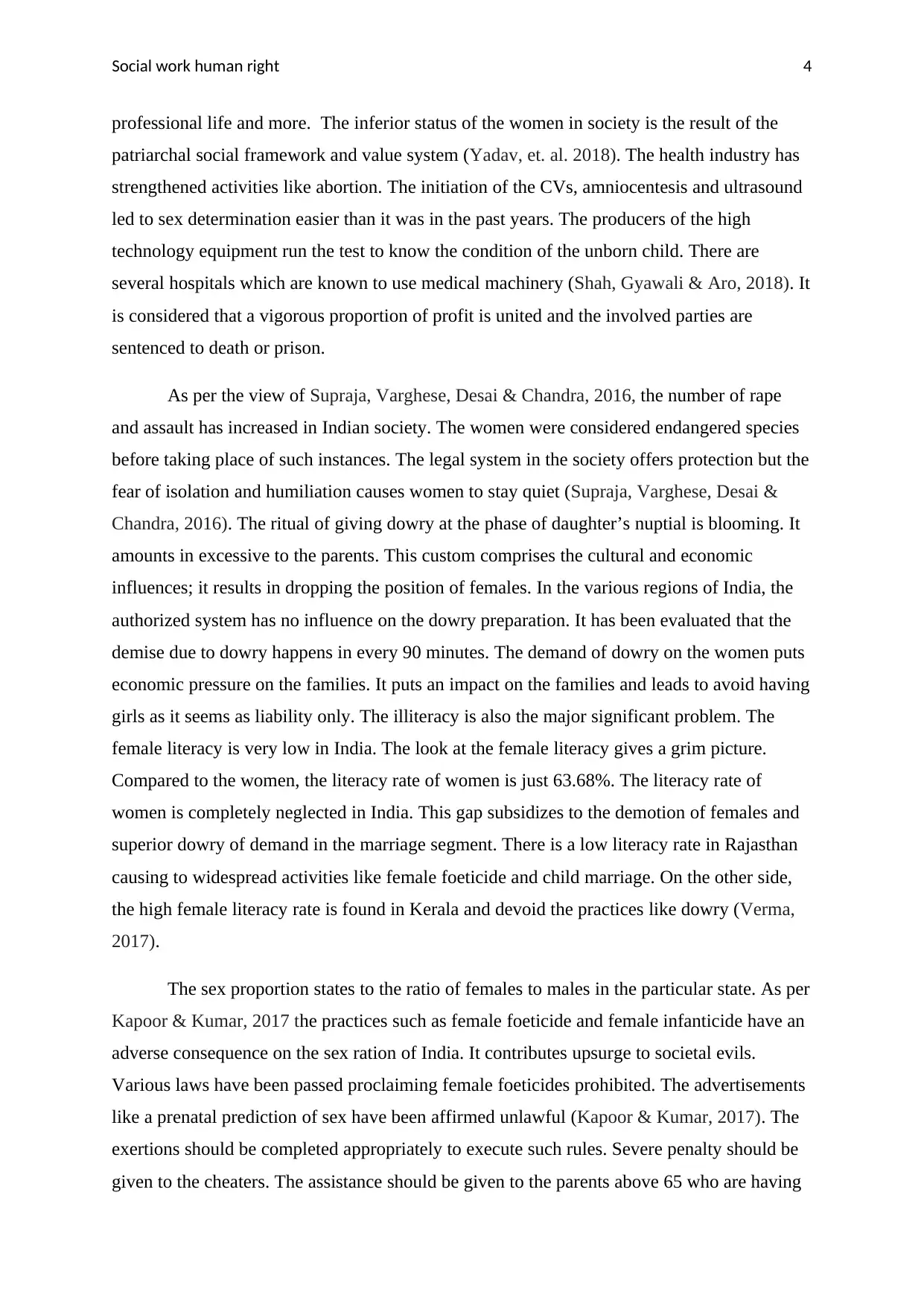
Social work human right 4
professional life and more. The inferior status of the women in society is the result of the
patriarchal social framework and value system (Yadav, et. al. 2018). The health industry has
strengthened activities like abortion. The initiation of the CVs, amniocentesis and ultrasound
led to sex determination easier than it was in the past years. The producers of the high
technology equipment run the test to know the condition of the unborn child. There are
several hospitals which are known to use medical machinery (Shah, Gyawali & Aro, 2018). It
is considered that a vigorous proportion of profit is united and the involved parties are
sentenced to death or prison.
As per the view of Supraja, Varghese, Desai & Chandra, 2016, the number of rape
and assault has increased in Indian society. The women were considered endangered species
before taking place of such instances. The legal system in the society offers protection but the
fear of isolation and humiliation causes women to stay quiet (Supraja, Varghese, Desai &
Chandra, 2016). The ritual of giving dowry at the phase of daughter’s nuptial is blooming. It
amounts in excessive to the parents. This custom comprises the cultural and economic
influences; it results in dropping the position of females. In the various regions of India, the
authorized system has no influence on the dowry preparation. It has been evaluated that the
demise due to dowry happens in every 90 minutes. The demand of dowry on the women puts
economic pressure on the families. It puts an impact on the families and leads to avoid having
girls as it seems as liability only. The illiteracy is also the major significant problem. The
female literacy is very low in India. The look at the female literacy gives a grim picture.
Compared to the women, the literacy rate of women is just 63.68%. The literacy rate of
women is completely neglected in India. This gap subsidizes to the demotion of females and
superior dowry of demand in the marriage segment. There is a low literacy rate in Rajasthan
causing to widespread activities like female foeticide and child marriage. On the other side,
the high female literacy rate is found in Kerala and devoid the practices like dowry (Verma,
2017).
The sex proportion states to the ratio of females to males in the particular state. As per
Kapoor & Kumar, 2017 the practices such as female foeticide and female infanticide have an
adverse consequence on the sex ration of India. It contributes upsurge to societal evils.
Various laws have been passed proclaiming female foeticides prohibited. The advertisements
like a prenatal prediction of sex have been affirmed unlawful (Kapoor & Kumar, 2017). The
exertions should be completed appropriately to execute such rules. Severe penalty should be
given to the cheaters. The assistance should be given to the parents above 65 who are having
professional life and more. The inferior status of the women in society is the result of the
patriarchal social framework and value system (Yadav, et. al. 2018). The health industry has
strengthened activities like abortion. The initiation of the CVs, amniocentesis and ultrasound
led to sex determination easier than it was in the past years. The producers of the high
technology equipment run the test to know the condition of the unborn child. There are
several hospitals which are known to use medical machinery (Shah, Gyawali & Aro, 2018). It
is considered that a vigorous proportion of profit is united and the involved parties are
sentenced to death or prison.
As per the view of Supraja, Varghese, Desai & Chandra, 2016, the number of rape
and assault has increased in Indian society. The women were considered endangered species
before taking place of such instances. The legal system in the society offers protection but the
fear of isolation and humiliation causes women to stay quiet (Supraja, Varghese, Desai &
Chandra, 2016). The ritual of giving dowry at the phase of daughter’s nuptial is blooming. It
amounts in excessive to the parents. This custom comprises the cultural and economic
influences; it results in dropping the position of females. In the various regions of India, the
authorized system has no influence on the dowry preparation. It has been evaluated that the
demise due to dowry happens in every 90 minutes. The demand of dowry on the women puts
economic pressure on the families. It puts an impact on the families and leads to avoid having
girls as it seems as liability only. The illiteracy is also the major significant problem. The
female literacy is very low in India. The look at the female literacy gives a grim picture.
Compared to the women, the literacy rate of women is just 63.68%. The literacy rate of
women is completely neglected in India. This gap subsidizes to the demotion of females and
superior dowry of demand in the marriage segment. There is a low literacy rate in Rajasthan
causing to widespread activities like female foeticide and child marriage. On the other side,
the high female literacy rate is found in Kerala and devoid the practices like dowry (Verma,
2017).
The sex proportion states to the ratio of females to males in the particular state. As per
Kapoor & Kumar, 2017 the practices such as female foeticide and female infanticide have an
adverse consequence on the sex ration of India. It contributes upsurge to societal evils.
Various laws have been passed proclaiming female foeticides prohibited. The advertisements
like a prenatal prediction of sex have been affirmed unlawful (Kapoor & Kumar, 2017). The
exertions should be completed appropriately to execute such rules. Severe penalty should be
given to the cheaters. The assistance should be given to the parents above 65 who are having
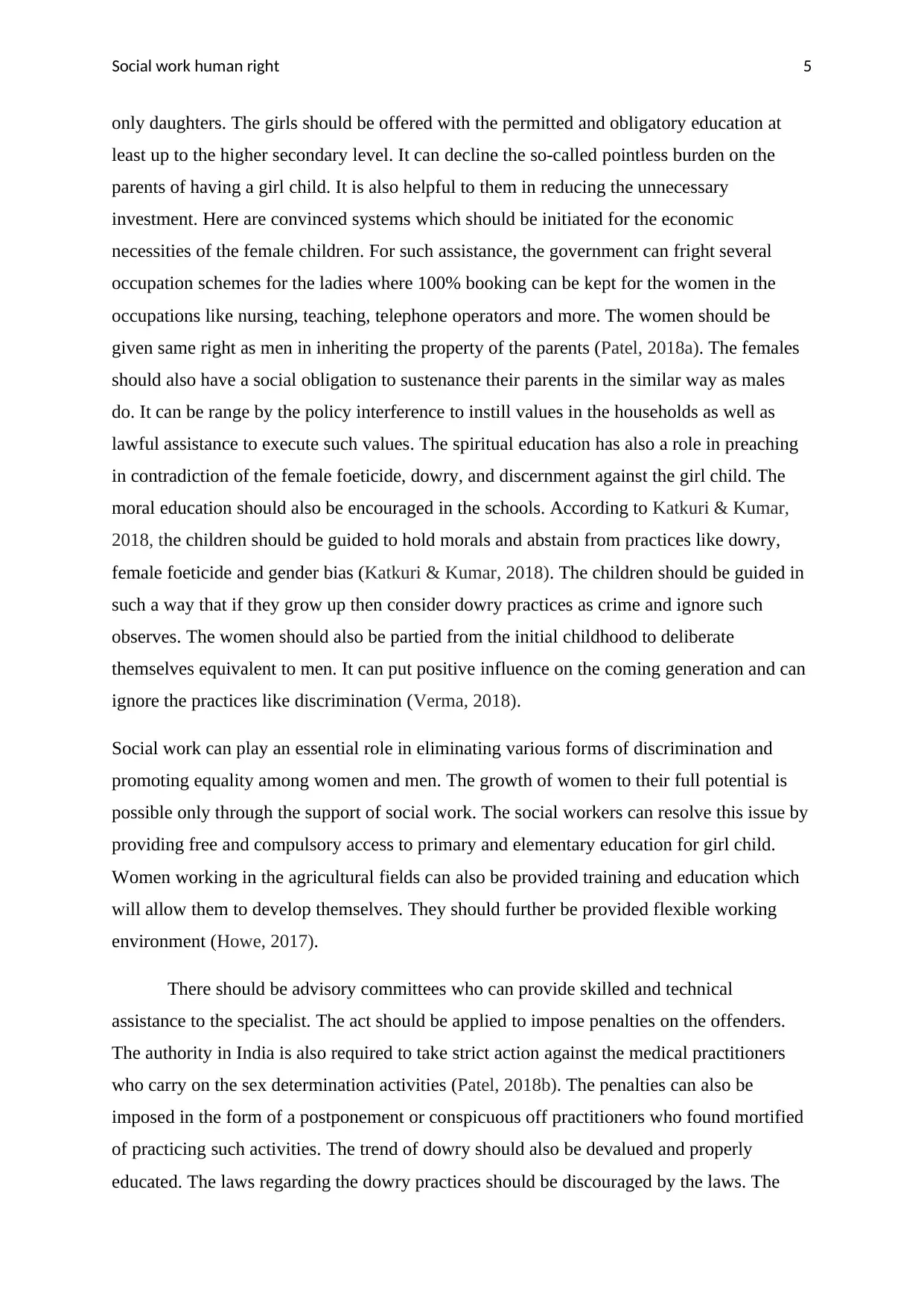
Social work human right 5
only daughters. The girls should be offered with the permitted and obligatory education at
least up to the higher secondary level. It can decline the so-called pointless burden on the
parents of having a girl child. It is also helpful to them in reducing the unnecessary
investment. Here are convinced systems which should be initiated for the economic
necessities of the female children. For such assistance, the government can fright several
occupation schemes for the ladies where 100% booking can be kept for the women in the
occupations like nursing, teaching, telephone operators and more. The women should be
given same right as men in inheriting the property of the parents (Patel, 2018a). The females
should also have a social obligation to sustenance their parents in the similar way as males
do. It can be range by the policy interference to instill values in the households as well as
lawful assistance to execute such values. The spiritual education has also a role in preaching
in contradiction of the female foeticide, dowry, and discernment against the girl child. The
moral education should also be encouraged in the schools. According to Katkuri & Kumar,
2018, the children should be guided to hold morals and abstain from practices like dowry,
female foeticide and gender bias (Katkuri & Kumar, 2018). The children should be guided in
such a way that if they grow up then consider dowry practices as crime and ignore such
observes. The women should also be partied from the initial childhood to deliberate
themselves equivalent to men. It can put positive influence on the coming generation and can
ignore the practices like discrimination (Verma, 2018).
Social work can play an essential role in eliminating various forms of discrimination and
promoting equality among women and men. The growth of women to their full potential is
possible only through the support of social work. The social workers can resolve this issue by
providing free and compulsory access to primary and elementary education for girl child.
Women working in the agricultural fields can also be provided training and education which
will allow them to develop themselves. They should further be provided flexible working
environment (Howe, 2017).
There should be advisory committees who can provide skilled and technical
assistance to the specialist. The act should be applied to impose penalties on the offenders.
The authority in India is also required to take strict action against the medical practitioners
who carry on the sex determination activities (Patel, 2018b). The penalties can also be
imposed in the form of a postponement or conspicuous off practitioners who found mortified
of practicing such activities. The trend of dowry should also be devalued and properly
educated. The laws regarding the dowry practices should be discouraged by the laws. The
only daughters. The girls should be offered with the permitted and obligatory education at
least up to the higher secondary level. It can decline the so-called pointless burden on the
parents of having a girl child. It is also helpful to them in reducing the unnecessary
investment. Here are convinced systems which should be initiated for the economic
necessities of the female children. For such assistance, the government can fright several
occupation schemes for the ladies where 100% booking can be kept for the women in the
occupations like nursing, teaching, telephone operators and more. The women should be
given same right as men in inheriting the property of the parents (Patel, 2018a). The females
should also have a social obligation to sustenance their parents in the similar way as males
do. It can be range by the policy interference to instill values in the households as well as
lawful assistance to execute such values. The spiritual education has also a role in preaching
in contradiction of the female foeticide, dowry, and discernment against the girl child. The
moral education should also be encouraged in the schools. According to Katkuri & Kumar,
2018, the children should be guided to hold morals and abstain from practices like dowry,
female foeticide and gender bias (Katkuri & Kumar, 2018). The children should be guided in
such a way that if they grow up then consider dowry practices as crime and ignore such
observes. The women should also be partied from the initial childhood to deliberate
themselves equivalent to men. It can put positive influence on the coming generation and can
ignore the practices like discrimination (Verma, 2018).
Social work can play an essential role in eliminating various forms of discrimination and
promoting equality among women and men. The growth of women to their full potential is
possible only through the support of social work. The social workers can resolve this issue by
providing free and compulsory access to primary and elementary education for girl child.
Women working in the agricultural fields can also be provided training and education which
will allow them to develop themselves. They should further be provided flexible working
environment (Howe, 2017).
There should be advisory committees who can provide skilled and technical
assistance to the specialist. The act should be applied to impose penalties on the offenders.
The authority in India is also required to take strict action against the medical practitioners
who carry on the sex determination activities (Patel, 2018b). The penalties can also be
imposed in the form of a postponement or conspicuous off practitioners who found mortified
of practicing such activities. The trend of dowry should also be devalued and properly
educated. The laws regarding the dowry practices should be discouraged by the laws. The
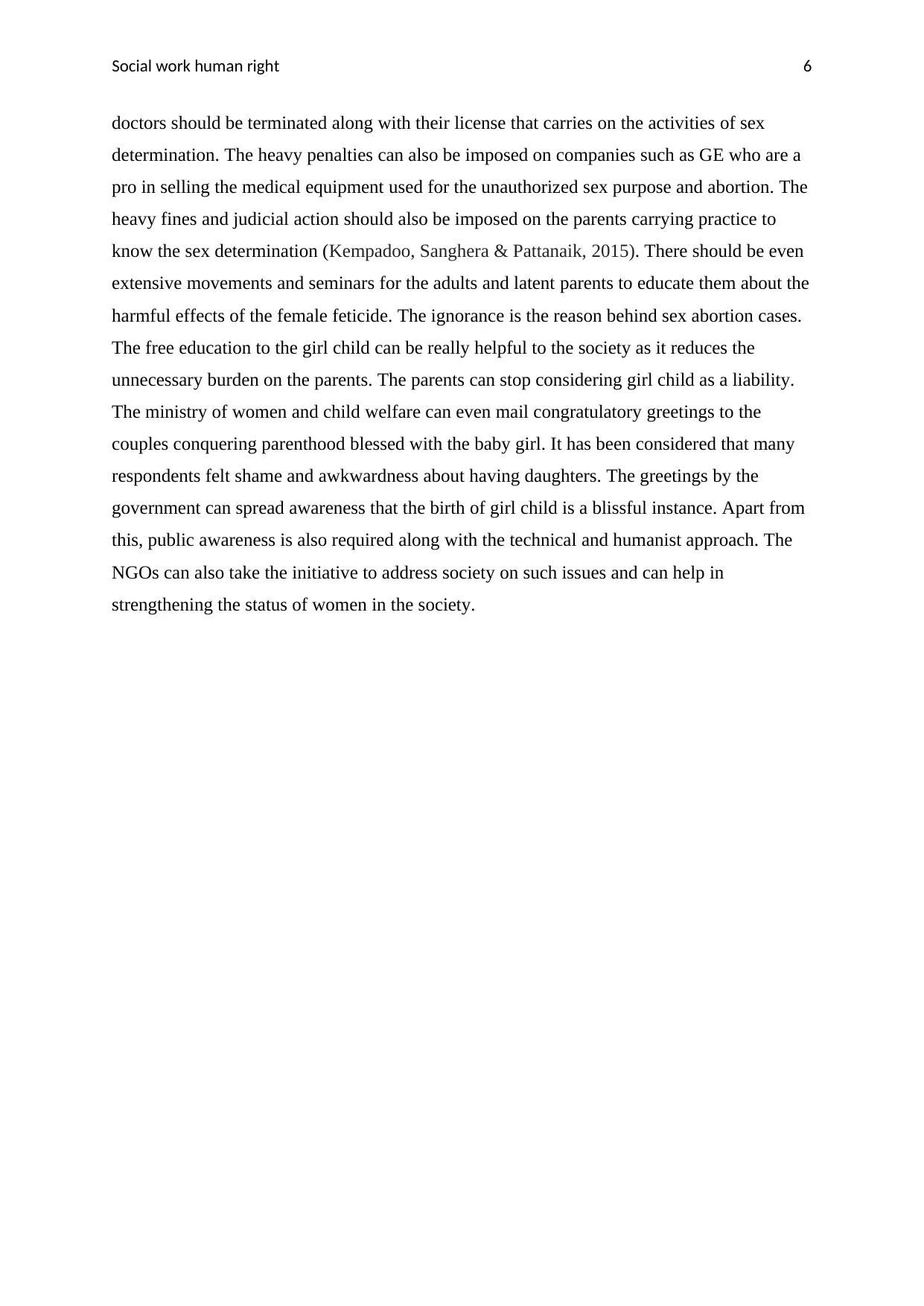
Social work human right 6
doctors should be terminated along with their license that carries on the activities of sex
determination. The heavy penalties can also be imposed on companies such as GE who are a
pro in selling the medical equipment used for the unauthorized sex purpose and abortion. The
heavy fines and judicial action should also be imposed on the parents carrying practice to
know the sex determination (Kempadoo, Sanghera & Pattanaik, 2015). There should be even
extensive movements and seminars for the adults and latent parents to educate them about the
harmful effects of the female feticide. The ignorance is the reason behind sex abortion cases.
The free education to the girl child can be really helpful to the society as it reduces the
unnecessary burden on the parents. The parents can stop considering girl child as a liability.
The ministry of women and child welfare can even mail congratulatory greetings to the
couples conquering parenthood blessed with the baby girl. It has been considered that many
respondents felt shame and awkwardness about having daughters. The greetings by the
government can spread awareness that the birth of girl child is a blissful instance. Apart from
this, public awareness is also required along with the technical and humanist approach. The
NGOs can also take the initiative to address society on such issues and can help in
strengthening the status of women in the society.
doctors should be terminated along with their license that carries on the activities of sex
determination. The heavy penalties can also be imposed on companies such as GE who are a
pro in selling the medical equipment used for the unauthorized sex purpose and abortion. The
heavy fines and judicial action should also be imposed on the parents carrying practice to
know the sex determination (Kempadoo, Sanghera & Pattanaik, 2015). There should be even
extensive movements and seminars for the adults and latent parents to educate them about the
harmful effects of the female feticide. The ignorance is the reason behind sex abortion cases.
The free education to the girl child can be really helpful to the society as it reduces the
unnecessary burden on the parents. The parents can stop considering girl child as a liability.
The ministry of women and child welfare can even mail congratulatory greetings to the
couples conquering parenthood blessed with the baby girl. It has been considered that many
respondents felt shame and awkwardness about having daughters. The greetings by the
government can spread awareness that the birth of girl child is a blissful instance. Apart from
this, public awareness is also required along with the technical and humanist approach. The
NGOs can also take the initiative to address society on such issues and can help in
strengthening the status of women in the society.
Paraphrase This Document
Need a fresh take? Get an instant paraphrase of this document with our AI Paraphraser
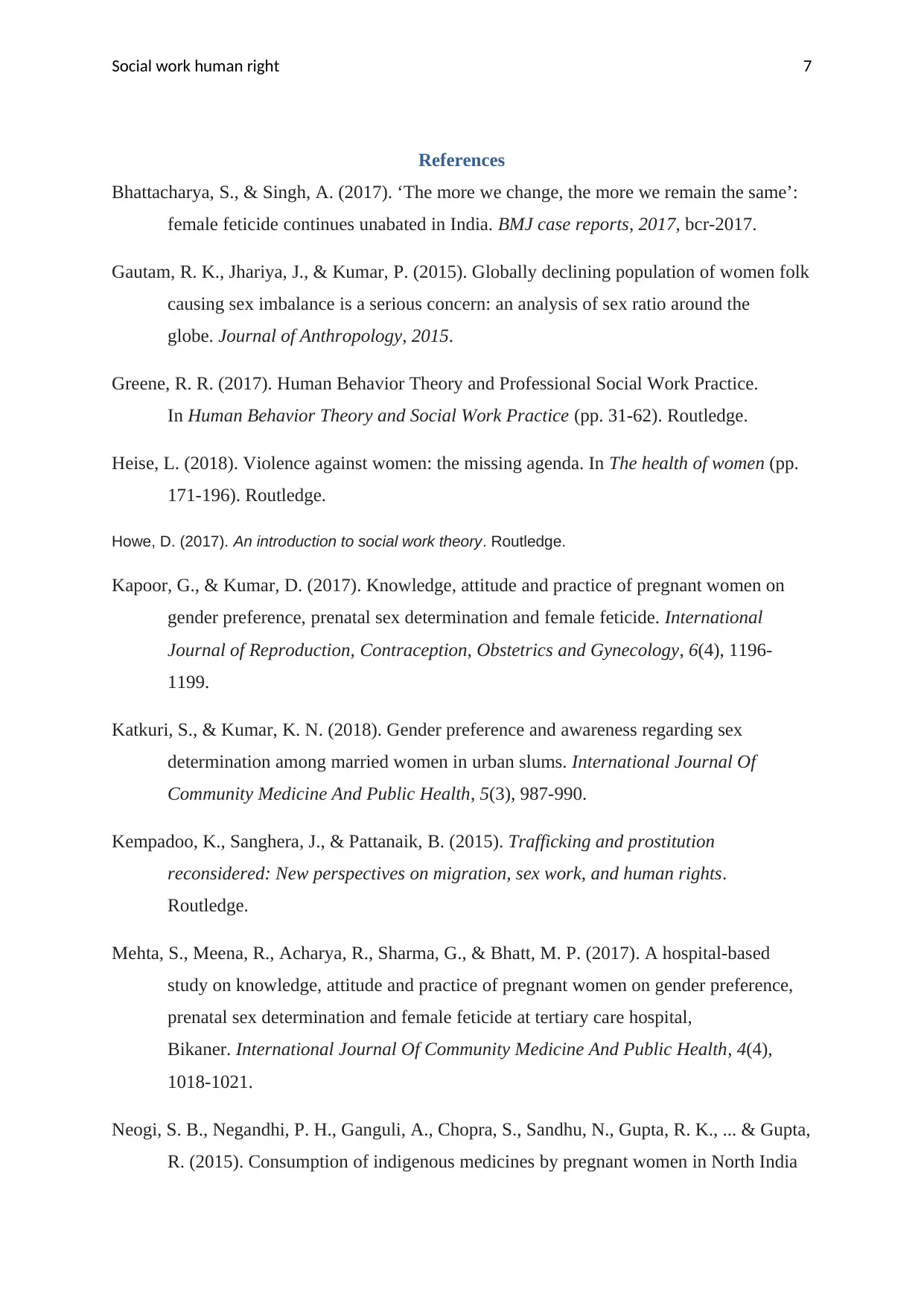
Social work human right 7
References
Bhattacharya, S., & Singh, A. (2017). ‘The more we change, the more we remain the same’:
female feticide continues unabated in India. BMJ case reports, 2017, bcr-2017.
Gautam, R. K., Jhariya, J., & Kumar, P. (2015). Globally declining population of women folk
causing sex imbalance is a serious concern: an analysis of sex ratio around the
globe. Journal of Anthropology, 2015.
Greene, R. R. (2017). Human Behavior Theory and Professional Social Work Practice.
In Human Behavior Theory and Social Work Practice (pp. 31-62). Routledge.
Heise, L. (2018). Violence against women: the missing agenda. In The health of women (pp.
171-196). Routledge.
Howe, D. (2017). An introduction to social work theory. Routledge.
Kapoor, G., & Kumar, D. (2017). Knowledge, attitude and practice of pregnant women on
gender preference, prenatal sex determination and female feticide. International
Journal of Reproduction, Contraception, Obstetrics and Gynecology, 6(4), 1196-
1199.
Katkuri, S., & Kumar, K. N. (2018). Gender preference and awareness regarding sex
determination among married women in urban slums. International Journal Of
Community Medicine And Public Health, 5(3), 987-990.
Kempadoo, K., Sanghera, J., & Pattanaik, B. (2015). Trafficking and prostitution
reconsidered: New perspectives on migration, sex work, and human rights.
Routledge.
Mehta, S., Meena, R., Acharya, R., Sharma, G., & Bhatt, M. P. (2017). A hospital-based
study on knowledge, attitude and practice of pregnant women on gender preference,
prenatal sex determination and female feticide at tertiary care hospital,
Bikaner. International Journal Of Community Medicine And Public Health, 4(4),
1018-1021.
Neogi, S. B., Negandhi, P. H., Ganguli, A., Chopra, S., Sandhu, N., Gupta, R. K., ... & Gupta,
R. (2015). Consumption of indigenous medicines by pregnant women in North India
References
Bhattacharya, S., & Singh, A. (2017). ‘The more we change, the more we remain the same’:
female feticide continues unabated in India. BMJ case reports, 2017, bcr-2017.
Gautam, R. K., Jhariya, J., & Kumar, P. (2015). Globally declining population of women folk
causing sex imbalance is a serious concern: an analysis of sex ratio around the
globe. Journal of Anthropology, 2015.
Greene, R. R. (2017). Human Behavior Theory and Professional Social Work Practice.
In Human Behavior Theory and Social Work Practice (pp. 31-62). Routledge.
Heise, L. (2018). Violence against women: the missing agenda. In The health of women (pp.
171-196). Routledge.
Howe, D. (2017). An introduction to social work theory. Routledge.
Kapoor, G., & Kumar, D. (2017). Knowledge, attitude and practice of pregnant women on
gender preference, prenatal sex determination and female feticide. International
Journal of Reproduction, Contraception, Obstetrics and Gynecology, 6(4), 1196-
1199.
Katkuri, S., & Kumar, K. N. (2018). Gender preference and awareness regarding sex
determination among married women in urban slums. International Journal Of
Community Medicine And Public Health, 5(3), 987-990.
Kempadoo, K., Sanghera, J., & Pattanaik, B. (2015). Trafficking and prostitution
reconsidered: New perspectives on migration, sex work, and human rights.
Routledge.
Mehta, S., Meena, R., Acharya, R., Sharma, G., & Bhatt, M. P. (2017). A hospital-based
study on knowledge, attitude and practice of pregnant women on gender preference,
prenatal sex determination and female feticide at tertiary care hospital,
Bikaner. International Journal Of Community Medicine And Public Health, 4(4),
1018-1021.
Neogi, S. B., Negandhi, P. H., Ganguli, A., Chopra, S., Sandhu, N., Gupta, R. K., ... & Gupta,
R. (2015). Consumption of indigenous medicines by pregnant women in North India
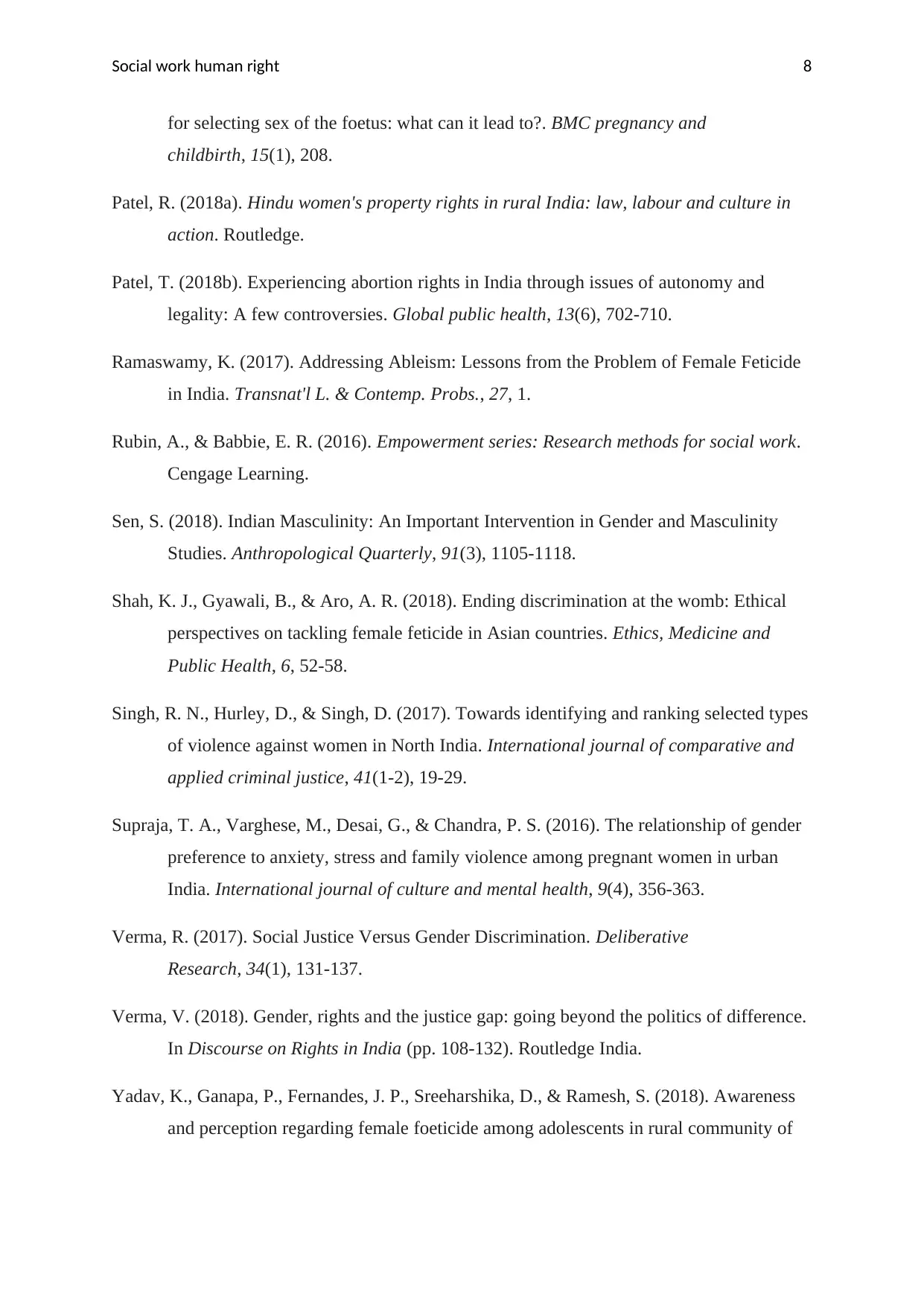
Social work human right 8
for selecting sex of the foetus: what can it lead to?. BMC pregnancy and
childbirth, 15(1), 208.
Patel, R. (2018a). Hindu women's property rights in rural India: law, labour and culture in
action. Routledge.
Patel, T. (2018b). Experiencing abortion rights in India through issues of autonomy and
legality: A few controversies. Global public health, 13(6), 702-710.
Ramaswamy, K. (2017). Addressing Ableism: Lessons from the Problem of Female Feticide
in India. Transnat'l L. & Contemp. Probs., 27, 1.
Rubin, A., & Babbie, E. R. (2016). Empowerment series: Research methods for social work.
Cengage Learning.
Sen, S. (2018). Indian Masculinity: An Important Intervention in Gender and Masculinity
Studies. Anthropological Quarterly, 91(3), 1105-1118.
Shah, K. J., Gyawali, B., & Aro, A. R. (2018). Ending discrimination at the womb: Ethical
perspectives on tackling female feticide in Asian countries. Ethics, Medicine and
Public Health, 6, 52-58.
Singh, R. N., Hurley, D., & Singh, D. (2017). Towards identifying and ranking selected types
of violence against women in North India. International journal of comparative and
applied criminal justice, 41(1-2), 19-29.
Supraja, T. A., Varghese, M., Desai, G., & Chandra, P. S. (2016). The relationship of gender
preference to anxiety, stress and family violence among pregnant women in urban
India. International journal of culture and mental health, 9(4), 356-363.
Verma, R. (2017). Social Justice Versus Gender Discrimination. Deliberative
Research, 34(1), 131-137.
Verma, V. (2018). Gender, rights and the justice gap: going beyond the politics of difference.
In Discourse on Rights in India (pp. 108-132). Routledge India.
Yadav, K., Ganapa, P., Fernandes, J. P., Sreeharshika, D., & Ramesh, S. (2018). Awareness
and perception regarding female foeticide among adolescents in rural community of
for selecting sex of the foetus: what can it lead to?. BMC pregnancy and
childbirth, 15(1), 208.
Patel, R. (2018a). Hindu women's property rights in rural India: law, labour and culture in
action. Routledge.
Patel, T. (2018b). Experiencing abortion rights in India through issues of autonomy and
legality: A few controversies. Global public health, 13(6), 702-710.
Ramaswamy, K. (2017). Addressing Ableism: Lessons from the Problem of Female Feticide
in India. Transnat'l L. & Contemp. Probs., 27, 1.
Rubin, A., & Babbie, E. R. (2016). Empowerment series: Research methods for social work.
Cengage Learning.
Sen, S. (2018). Indian Masculinity: An Important Intervention in Gender and Masculinity
Studies. Anthropological Quarterly, 91(3), 1105-1118.
Shah, K. J., Gyawali, B., & Aro, A. R. (2018). Ending discrimination at the womb: Ethical
perspectives on tackling female feticide in Asian countries. Ethics, Medicine and
Public Health, 6, 52-58.
Singh, R. N., Hurley, D., & Singh, D. (2017). Towards identifying and ranking selected types
of violence against women in North India. International journal of comparative and
applied criminal justice, 41(1-2), 19-29.
Supraja, T. A., Varghese, M., Desai, G., & Chandra, P. S. (2016). The relationship of gender
preference to anxiety, stress and family violence among pregnant women in urban
India. International journal of culture and mental health, 9(4), 356-363.
Verma, R. (2017). Social Justice Versus Gender Discrimination. Deliberative
Research, 34(1), 131-137.
Verma, V. (2018). Gender, rights and the justice gap: going beyond the politics of difference.
In Discourse on Rights in India (pp. 108-132). Routledge India.
Yadav, K., Ganapa, P., Fernandes, J. P., Sreeharshika, D., & Ramesh, S. (2018). Awareness
and perception regarding female foeticide among adolescents in rural community of

Social work human right 9
Nalgonda district, Telangana. International Journal Of Community Medicine And
Public Health, 5(7), 3106-3110.
Nalgonda district, Telangana. International Journal Of Community Medicine And
Public Health, 5(7), 3106-3110.
1 out of 10
Your All-in-One AI-Powered Toolkit for Academic Success.
+13062052269
info@desklib.com
Available 24*7 on WhatsApp / Email
![[object Object]](/_next/static/media/star-bottom.7253800d.svg)
Unlock your academic potential
© 2024 | Zucol Services PVT LTD | All rights reserved.